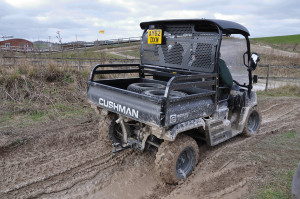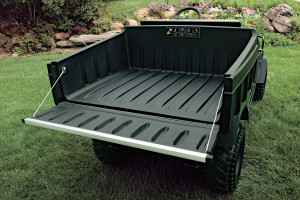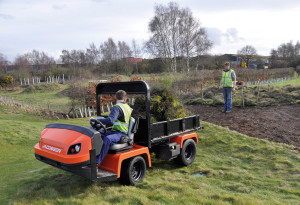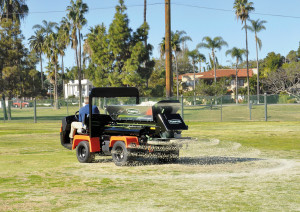Utility Vehicles - Which one is right for you?

Application
Any decision has to be made with a real focus on what the vehicle is actually going to do for you. The application has to be the starting point and, from that, you can develop a list of minimum requirements in terms of the payload, transmission capabilities, ground clearance, engine power, transmission type and comfort requirements. A golf buggy derived utility vehicle will have a smooth and quiet ride, but it won't like rough ground or load carrying duties.
Key questions to ask would include the following:
- How many people will it need to carry, what type of ground will it run on?
- How far will it have to travel in a day, how long will a working day be?
- What will it carry, how much weight, and how big will the cargo box need to be?
- Will it be used to tow a trailer?
There are several tyres, or categories within the utility vehicle market, and understanding these will assist in selecting the right one for your application.
The Golf Car
The least expensive, and the most popular due to fleet sales to golf courses, is the golf car commandeered by the greens staff. It is the lightest, simplest to operate, and the easiest to get on and off. However, they are limited to who and what they can carry. Power will be from a small petrol engine or a battery pack. The benefit of electric golf cars is that they are virtually silent, so they can work well in noise sensitive areas, where the requirement is to move people quickly, easily and efficiently.
Look for models with re-gen braking systems, which prevent the vehicle from running away downhill. The transmission also recharges the battery pack on these models. Not only does this give you longer run times, it saves on brake wear and it's much safer as well.
Some models now have automatic parking brakes, which apply whenever you stop. You don't have to apply the brake before leaving the vehicle, or remember to release it, before moving off.
The downside is a lack of carrying capacity, but there are box and load tray accessories, provided there is not too much weight or bulk. Another drawback to the golf car can be the lack of ground clearance, when used on open ground. This again can be easily solved by fitting lift kits and larger wheels, making a customised golf car look very different from the original vehicle!
Light Duty Utility

As with the golf car, the engine can be either petrol or battery. With electric power packs now available up to 72 volts, there is now plenty of driving range for all day operation. Battery chargers are now mounted on the vehicle, so all you need is a standard 3 pin socket to recharge.
Some vehicles in this class will have a limited slip differential to aid traction when driving off-road. At the top of this range there are units with larger diameter wheels, increased ground clearance and locking differentials, giving really good traction in off-road conditions. Given the lighter weight of these vehicles, and aggressive tyre options available, they can be a real alternative to the heavier and more expensive 4-wheel drive vehicles.
Medium Duty Utility
These vehicles are very different from a golf car! They are designed for heavy work in off-road environments and will have the ground clearance, transmissions and rugged suspension to cope with the task. Power comes now from either petrol or diesel engines. Battery options do exist, but there is a limit to the available range when driving off-road in 4-wheel drive.
Look on the specifications to see if there is a low range gearbox fitted, which is essential for heavy off-road use, particularly on banks and slopes. Braking will be on all four wheels for greater security, where the light duty vehicles tend to be rear wheel brakes only.
Diesel engines bring better fuel economy, but they are heavier, noisier and more expensive to buy. The noise and vibrations from the diesel engine can mean the ear protection is needed if operating these units for an extended time.

Transmissions tend to be CVT (continuously variable transmission) belt by design, with a low range box for additional traction and pulling power. There are hydrostatic models available which give enhanced downhill control, but are heavier, use more fuel and lose power through the transmission, when compared to the more popular CVT alternatives.
Cab options are also popular on these vehicles, as they will be fitted with a 4 post ROPS frame as standard. A roof and front windscreen makes are real difference when operating in poor weather. Fitting doors is an option, but the full cab versions tend to be noisy and it's difficult to stop the screen from fogging up on a wet day!
There is a wide range of accessories available for these vehicles. Optional hydraulic packs and 12v power supply mean that power driven spreaders and sprayers, as well as yard brushes and snow ploughs can all be fitted to the medium duty vehicle.
Heavy Duty work vehicles

These are prime movers, which can have a range of attachment fitted to them. Mainly designed for golf course work, they have low ground pressure, good clearance and offer a real alternative to a compact tractor, particularly as the attachments sit on the chassis, and so do not increase the length of the vehicle, or compromise its manoeuvrability.
A hydraulic pump is standard and this allows hydraulically driven attachments to be easily fitted to the vehicle. This has now replaced the mechanical PTO shafts that were used to run such accessories as topdressers, sprayers and spreaders.
Whilst the majority of these vehicles are sold as 2-wheel drive, there are 4-wheel drive versions available for more extreme applications. The performance in 4-wheel drive mode can be surprisingly good, and without the surface damage created by vehicles fitted with road tyres.
So, you have a wide range of vehicles to choose from. In price, specification and performance there is a vehicle out there to suit your needs and application. Like most things in the professional turfcare industry, it's about understanding your application and then selecting the right tool for the job.
